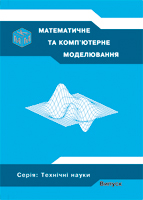Модель життєвого циклу дефекту програмного забезпечення
DOI:
https://doi.org/10.32626/2308-5916.2020-21.51-60Анотація
Процес розробки програмного забезпечення включає в себе обов'язковий додатковий процес забезпечення якості програмного забезпечення, який являє собою сукупність заходів, що охоплюють всі технологічні етапи розробки, випуску та експлуатації програмного забезпечення інформаційних систем, що проводяться на різних етапах життєвого циклу програмного забезпечення для забезпечення необхідного рівня якості програмного забезпечення. Одне з основних завдань такого процесу полягає в знаходженні і усуненні дефектів програмного забезпечення. Дана робота присвячена формальному представленню життєвого циклу дефекту програмного забезпечення. Модель життєвого циклу дефекту програмного забезпечення розглядається як ланцюжок, який починається з помилки розробника і закінчується відмовою програмного забезпечення. У статті подається загальна структура моделі дефекту життєвого циклу програмного забезпечення, яка включає в себе помилку розробника, помилку оператора, прихований дефект у програмному забезпеченні, активний дефект у програмному забезпеченні, помилку обчислення, збій або відмову, породжену вразливість, активовану вразливість, несанкціоноване управління та несанкціонований доступ до даних. Така модель деталізується в набір патологічних ланцюжків, які структурно представляють модифікації життєвого циклу дефекту програмного забезпечення з урахуванням природи виникнення самого дефекту програмного забезпечення. Серед патологічних ланцюжків виділяють наступні: фізичний, проектування, розробки та взаємодії. Патологічний ланцюжок взаємодії деталізується ще на патологічний ланцюжок взаємодії внаслідок фізичного впливу і патологічний ланцюжок взаємодії внаслідок інформаційного впливу. Дана модель життєвого циклу дефекту програмного забезпечення проектується на V-подібну модель розробки програмного забезпечення, що дозволяє представити своєрідну еволюцію дефекту програмного забезпечення на кожному етапі життєвого циклу розробки програмного забезпечення окремо і в рамках всієї
V-подібної моделі розробки програмного забезпечення.
Посилання
Software engineering. Report on a conference sponsored by the NATO science committee. Garmisch, Germany, 7-11 October, 1968. URL: http://homepages.cs.ncl.ac.uk/brian.randell/NATO/nato1968.PDF.
Wagner S. Software Product Quality Control: book. Heidelberg: Springer. 2013. 210 p.
Gao J., Zhang L., Zhao F., Zhai Ye. Research on Software Defect Classification. In proceedings of the IEEE 3rd Information Technology, Networking, Electronic and Automation Control Conference (ITNEC-2019). URL: https://ieeexplore.ieee.org/document/8729440/authors#authors.
TOP 5 Software Failures of 2018–2019. Website Checkio. URL: https://blog.checkio.org/%EF%B8%8F-top-5-software-failures-of-2018-2019-5-is-pretty-alarming-2a5400b01658.
Han W., Jiang H., Li W., Li Ye. A Summary of Software Defect Model. In proceedings of the IEEE 7th International Conference on Control and Automation (ICCA-2014). URL: https://ieeexplore.ieee.org/document/7026263.
Han W., Jiang H. Y., Lu T. B., Zhang X. Y., Li W. Software defect model based on similarity and association rule. International Journal of Multimedia and Ubiquitous Engineering. 2015. Vol. 10(7). P. 1-10. URL: http://gvpress.com/journals/IJMUE/vol10_no7/1.pdf.
Frattini F., Pietrantuono R., Russo S. Reproducibility of Software Bugs. In: Fiondella L., Puliafito A. (eds) Principles of Performance and Reliability Modeling and Evaluation. Springer Series in Reliability Engineering. Springer, Cham. 2016. P 551-565. URL: https://link.springer.com/chapter/10.1007%2F978-3-319-30599-8_21.
Singh P. Learning from Software defect datasets. In proceedings of the 5th International Conference on Signal Processing, Computing and Control (ISPCC-2019). URL: https://ieeexplore.ieee.org/document/8988366.
Rahman A., Nurdatillah H. Defect Management Life Cycle Process for Software Quality Improvement. In proceedings of the 3rd International Conference on Artificial Intelligence, Modelling & Simulation (AIMS-2015). URL: https://ieeexplore.ieee.org/document/7604582.
Koponen T. Life cycle of Defects in Open Source Software Projects. In: Damiani E., Fitzgerald B., Scacchi W., Scotto M., Succi G. (eds) Open Source Systems. OSS 2006. IFIP International Federation for Information Processing, vol 203. Springer, Boston, MA. URL: https://link.springer.com/-chapter/10.1007%2F0-387-34226-5_19.
##submission.downloads##
Опубліковано
Номер
Розділ
Ліцензія
Authors who publish with this journal agree to the following terms:- Authors retain copyright and grant the journal right of first publication with the work simultaneously licensed under a Creative Commons Attribution License that allows others to share the work with an acknowledgement of the work's authorship and initial publication in this journal.
- Authors are able to enter into separate, additional contractual arrangements for the non-exclusive distribution of the journal's published version of the work (e.g., post it to an institutional repository or publish it in a book), with an acknowledgement of its initial publication in this journal.
- Authors are permitted and encouraged to post their work online (e.g., in institutional repositories or on their website) prior to and during the submission process, as it can lead to productive exchanges, as well as earlier and greater citation of published work (See The Effect of Open Access).

